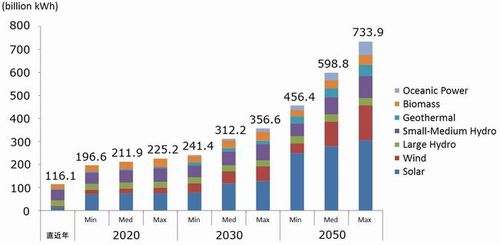July 3, 2015
MOE Forecasts 33% Renewables by 2030, Nuclear Plants Not Prerequisite for Energy Mix
Keywords: Energy Policy Government Renewable Energy
The Ministry of Environment (MOE) foresees that by implementing effective measures in addition to existing policies, renewable energy sources will expand to 33% of the domestic power mix by 2030. With permission from Smart Japan, which releases information on the latest developments in energy efficiency, storage, and generation, JFS has summarized an article, provided below, introducing MOE's forecast for renewable energy, which is more optimistic than that of the Ministry of Economics, Trade and Industries (METI).
The Ministry of the Environment commissioned the think-tank Mitsubishi Research Institute (MRI) to provide projections on the increase in renewable energy up to the year 2050. According to MRI's moderate estimate, taking reasonable measures to reduce CO2 emissions in addition to current policies, which are expected to be a minimal forecast taken alone, will result in 312.2 billion kWh of output from renewable sources in the year 2030.

Projections of Electricity Output from Renewable Energy, by Sources
(Prepared by JFS based on the data from the Ministry of the Environment)
Further breaking down the estimate, solar power is expected to rise to as much as 117.3 billion kWh, the largest jump thanks to a sharp increase in photovoltaic installation. It is followed by hydroelectric, which, combining existing large-scale plants with new small- to medium-sized facilities, is expected to grow to 86.3 billion kWh, and wind power, which looks to expand to 53.7 billion kWh. Also expected to show a sharp increase by 2030 are biomass, geothermal and oceanic power. Given the same level of total generating capacity in 2030 as in fiscal 2013, at 939.7 billion kWh, renewables in 2030 will constitute 33% of the energy mix, or up to 35% or more if power demands falls.
The total renewable installation capacity is expected to reach 164.91 million kilowatts in 2030 (moderate forecast), equivalent to that of 165 nuclear power plants. Although 60% of the renewable energy source is solar power, which would make the actual generation output about one third of nuclear power generation, we can still expect that by 2030, renewables will generate no less than all of the nuclear power plants in Japan when in operation.
MOE's estimate assumes that the feed-in-tariff scheme will continue to be in place. For solar and wind power generation, the estimate takes into account some degree of curtailment with every possible countermeasure taken, such as supply-demand adjustment over different regions. The purchase price of solar-generated electricity is assumed to go down gradually toward 2030, by which time the solar generation cost would drop to about the same level as thermal, reducing the cost difference that households would have to bear.
While nuclear power is not a part of MOE's estimate, in which renewables account for over 30%, METI's current discussion on the 2030 energy mix will most likely settle on 20% nuclear and 25% renewables. The only difference between MOE's and METI's future energy mixes is whether or not the restart of nuclear plants is a prerequisite. And that is precisely where the difference in renewable capacity comes from.
In order to reduce carbon emissions caused by power generation, either nuclear or renewables must be increased as power sources, and these two are handled differently in what METI and MOE foresee. Should we take advantage of existing facilities and assume a higher risk of radioactive contamination, or build new facilities and try to stabilize the power supply? This is a watershed moment for the future of this nation.
The International Energy Agency (IEA), which compiles the energy policies of member countries, predicts renewables will reach 30% of global energy sources in 2030. For Japan to catch up to that level, METI has to set its goal closer to MOE's estimate. And the two ministries have to work together to build an energy supply structure that suits Japan's status as an advanced nation.
Source: Smart Japan (in Japanese)
Related
"JFS Newsletter"
- 'Yumekaze' Wind Turbine Project Connects Metro Consumers and Regional Producers: Seikatsu Club Consumers' Co-operative
- Shaping Japan's Energy toward 2050 Participating in the Round Table for Studying Energy Situations
- Nishiawakura's Initiative for 100% Energy Self-Sufficiency, and a Municipal ICO Scheme
- Actions Toward 100% Renewable Energy in Japan
- Sustainable Community Building in Shimokawa: Recycling-Oriented Forest Management Enabling Permanent Use of Forest Resources
Related
"Popular Articles"
- Current Status of Renewable Energy in Japan (2015)
- Offshore Wind Farm Withstands Great East Japan Earthquake and Tsunami
- Current Status of Renewable Energy in Japan (2014)
- Geothermal Power: Japan Has World's Third Largest Geothermal Reserves, 60 Percent of Which Can Be Developed
- Tokyo Plans to Increase Renewable Energy Ratio to 20% by 2024


